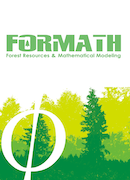In the growth analysis, when the research focus is environmental factor, the longitudinal growth part is essential but not our main interest. In such a situation, by regarding age dependent growth behavior as baseline, we can reconstruct the models to include a nuisance baseline. Such an approach makes it possible only to estimate parameters of interest (environmental factors) without information about the nuisance baseline. After estimating the main parameters, we can graph the baseline trend, non-parametrically. In this paper, the growth model was generated using data on Sugi (Cryptomeria Japonica) at Hoshino village in Japan. The results from this study showed an inverse relationship between altitude and tree growth, without modeling for longitudinal growth, i.e., higher altitude resulted in less tree growth. In practice the results can be explained by our knowledge based on two established facts. The first is based on the direction of water and nutrients flow from a higher elevation and accumulates at a lower elevation, and the second can be explained by the fact that trees are suppressed by strong winds at higher elevations. By using this data, we compared our model with traditionally used parametric growth models which are constructed without nuisance baseline. In statistical terms, both the variance of residual and the standard error for parameters in the proposed model were found to be the smallest among the other parametric alternatives. This implies that the estimate is stable in our model that is one of the advantage for statistical inference aspect.
抄録全体を表示
